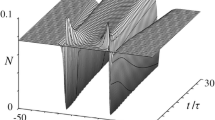Abstract
The diffusion processes in a layer of a photopolymerizable composition stimulated by non-stationary optical radiation causing the relocation of the neutral component concentration and formation of smooth distributions of the refractive index were investigated. By the method of computer simulation, it was shown that with the photopolymerization of such a multi-component medium, moving the illumination boundary along the polymerized layer makes it possible to create gradient polymer lenses with a parabolic and Gaussian profile of the refractive index. The experimental results on the optical formation of flat elements of gradient polymeric optics from the industrial oligomer OCM-2 with butanol as a neutral component are presented.







Similar content being viewed by others
References
Born M, Wolf E (1999) Principles of optics. Cambridge University, Cambridge
Ji S, Yin K, Mackey M, Brister A, Ponting M, Baer E (2013) Polymeric nanolayered gradient refractive index lenses: technology review and introduction of spherical gradient refractive index ball lenses. Opt Eng 52(11):112105
Dymshits OS, Zhilin AA, Shashkin AV (2008) Method of making glassceramic lens with refraction index gradient. Patent RU 2385845
Liu J-H, Wang H-Y, Ho C-H (2003) Fabrication and characterization of gradient refractive index plastic rods containing inorganic nanoparticles. J Polym Res 10:13–20
Yu M, Tsai M, Schmidt GR, Anthamatten M (2015) Gradient-index materials based on thiol − ene networks. ACS Appl Mater Interfaces 7:8601–8605
Veniaminov AV, Mahilny VV (2013) Holographic polymer materials with diffusion development: principles, arrangement, investigation, and applications. Opt Spectrosc 115(6):906–930
Tomita Y, Hata E, Momose K, Takayama S, Liu X, Chikama K, Klepp J, Pruner C, Fally M (2016) Photopolymerizable nanocomposite photonic materials and their holographic applications in light and neutron optics. J Modern Optics 63(S3):S1–S31
Lonin AL, Mensov SN, Polushtaytsev YV (2004) Causes of the filamentary instability of optical-beam self-channeling in Photopolymerizable compositions. JETP Lett 79(11):515–518
Baten’kin MA, Mensov SN, Romanov AV (2008) The use of low-viscosity neutral components for increasing the diffraction efficiency of photopolymer holograms. Opt Spectrosc 104(1):135–139
Mensov SN, Morozova MA, Polushtaytsev YV (2016) Formation of periodic phase structures in a Photopolymerizable layer by nonstationary light beams. Opt Spectrosc 121(3):438–444
Baten’kin MA, Mensov SN, Morozova MA, Polushtaytsev YV (2015) Neutral component localization in the volume of photopolymerizable medium by the counter moving boundaries of initiating radiation action. J Polym Res 22:247
Mensov SN, Morozova MA, Polushtaytsev YV (2018) Optical formation and transport of a local region with an increased content of a neutral component in a photopolymerizable composite layer. JETP Lett 108(8):553–556
Egorov GS, Stepanov NS (1982) Simulation of a gravitational lens in a lecture demonstration. Sov Phys Usp 25:705–707
Mayer VV (2007) Light in optically inhomogeneous medium. Physmathlit, Moscow [in russian]
Ya C, Gan Z, Jia B, Evans RA, Gu M (2011) High-photosensitive resin for super-resolution direct-laser-writing based on photoinhibited polymerization. Opt Express 19(20):19486–19494
Formana DL, Heuvelmanb GL, McLeoda RR (2012) Materials development for photoinhibited superresolution (PINSR) lithography. Proc SPIE 8249:824904
Kazak NS, Krening M, Mashchenko AG, Ropot PI (2007) A controlled conical Lens for the formation of Bessel light beams. Opt Spectrosc 130(5):826–830
Chesnokov SA, Cherkasov VK, Abakumov GA, Mamysheva ON, Chechet YV, Nevodchikov VI (2001) Influence of o-benzoquinone nature on initiation of radical polymerization by the o-benzoquinone – tert-amine system. Russ Chem Bull 50(12):2366–2371
Acknowledgments
This work was supported by by the Russian Science Foundation (proj. no. 15-13-00137-P).
Funding
Russian Science Foundation 15-13-00137-P.
Author information
Authors and Affiliations
Corresponding author
Additional information
Publisher’s note
Springer Nature remains neutral with regard to jurisdictional claims in published maps and institutional affiliations.
Rights and permissions
About this article
Cite this article
Polushtaytsev, Y.V., Mensov, S.N. Formation of gradient polymer lenses by non-stationary luminous flux. J Polym Res 26, 273 (2019). https://doi.org/10.1007/s10965-019-1968-1
Received:
Accepted:
Published:
DOI: https://doi.org/10.1007/s10965-019-1968-1




